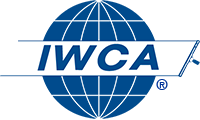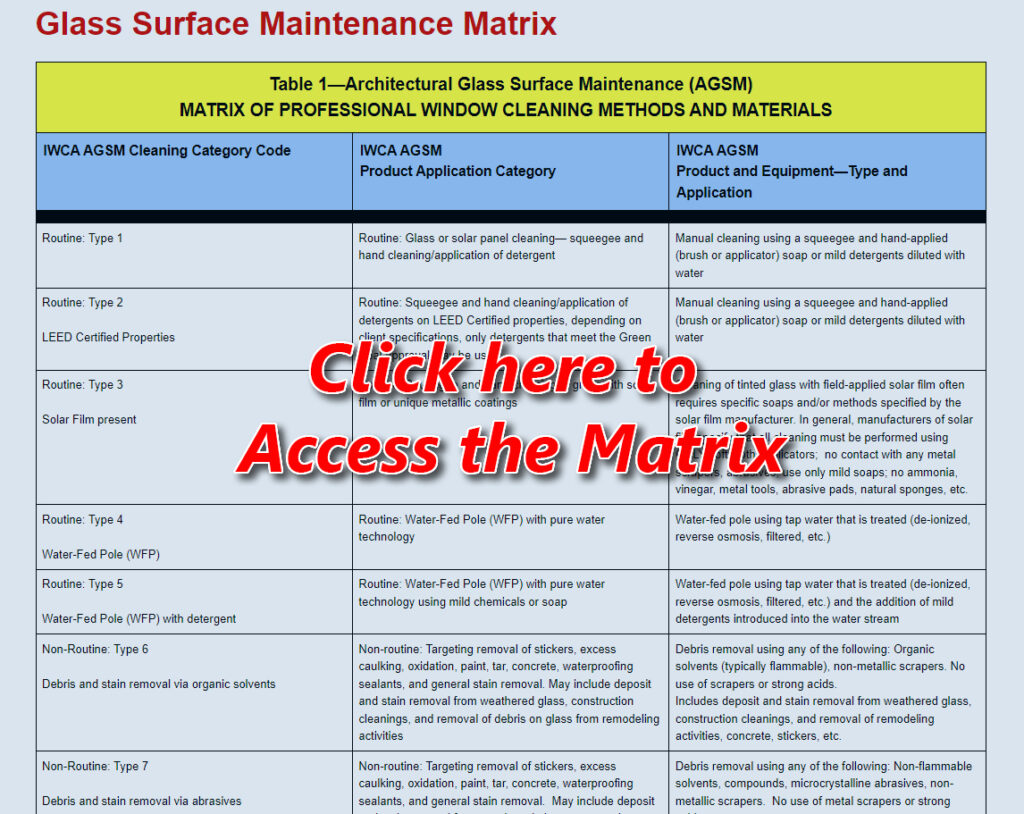Note: A PDF version of this Glass Matrix is forthcoming. Please check this page for future updates.
Introduction
This publication from the International Window Cleaning Association (IWCA) was created by the Glass Education Committee in 2023 as a specification for the commercial window cleaning industry. We would like to thank the IWCA and the committee for providing the resources for the initial launch, as well as funding to continue to provide updates.
This Matrix is designed to be used in conjunction with the most recent version of the IWCA Field Guide for Professional Window Cleaners. This Matrix provides in-depth performance guidelines and education on identifying stains and glass coatings and the Appendix provides lists of products categorized by aggressiveness and application method (manual or mechanical).
If your company manufactures window cleaning soaps, solvents, or glass restoration products that have been approved for use and are safe on architectural glass or solar panels and would like to submit your product(s) for registration listing in the Appendix, please contact info@iwca.org for information.
Foreword
By Tom Trinen, Chairman of the IWCA Glass Education Committee
This Matrix was developed by the IWCA Glass Education Committee and represents the first detailed specification to define the methods for commercial window cleaning. We would like to acknowledge the IWCA and the contributors of this information.
Our goal is to provide guidance and best practices for all levels of architectural window cleaning and solar cleaning, from routine (using common household detergents), to tenacious debris and stain removal and advanced restoration methods.
The cleaning categories are defined to provide a concise definition for the various types of commercially acceptable means and application methods and to identify solvents and products that have proven to be successful in removing common stains, deposits, or scratches in a searchable Appendix format.
These products and compounds must be commercially available and proven to be acceptable by the product manufacturer for the intended purpose and should harmonize with the approvals of the glass coatings and manufacturing industry as safe or effective at targeting the specific Type or level of cleaning or stain removal as defined by the Matrix.
Scope
Resource for window cleaning companies and building owners, managers, architects, general contractors, and stakeholders to establish protocol and assurances, and to standardize their scope of work for any commercial or residential window and solar cleaning or restoration project.
Purpose
The purpose of this Cleaning Matrix is to identify and provide standardized definitions and guidance for proven methods and materials for safe routine window cleaning, as well as products used for restoration, stain removal or repair, and identify which category a product falls into using this standard matrix.
This Matrix is intended for use by experienced window cleaners who understand how to identify deposits and stains, and that many types of glass and coatings or adjacent materials that can be damaged by certain products.
Goal
The goal of the IWCA is to maintain the searchable appendices listing registered cleaning products, restoration compounds, and abrasive technologies in alignment with the approval of the glass and coatings manufacturers.
Application—Non-Routine Projects
Every restoration or construction cleaning project is unique. This Matrix is designed to assist in the creation of the scope of work with consistent descriptions of the steps, the products to be used, the application methods, and subsequent steps, if necessary.
The Appendices list does not purport to include all products available and DOES NOT ENDORSE such products or claim to list all safety risks. It is NOT a safety standard.
CAUTION: The IWCA warns that the probability of financial assignment to the user or their company can be significant with some products (if used incorrectly), and if you are planning to engage in activities that carry a high probability of damage, you should see legal and professional advice to develop your scope of work and carry the necessary insurance to cover you for care and custody of your client’s property and educate your workforce to these guidelines.
Pre-existing damage should be well documented prior to the start of any successful project, and mockups should be performed whenever possible.
Overview
The Appendices (A, B, & C) of acceptable products have been compiled as a resource of compounds, solvents, and abrasives manufactured for a specific need.
Listings are open to all manufacturers: They must register their products with the IWCA and provide their potential benefits, associated risks, hazards, and incompatible materials. Each product listing shall include the application, both literally (i.e. “hand applied with a brush,” “water-fed pole,” etc.) and by “Category.” It is each manufacturer’s responsibility to test and properly identify the cleaning.
Routine Cleaning (Types 1 through 5) identifies the different types of mild detergent and pure water cleaning essentially designed to remove water-soluble dirt and debris without the further use of harsh chemicals, abrasives, or solvents, including water-fed poles (WFP), which use pure water technology.
Non-Routine Cleaning (Types 6 through 10) varies greatly from routine cleaning as Non-Routine Cleaning Types are categorized by progressively more intense methods of stain or debris removal, which is typically more complicated in the amount of labor, training, and material costs, and categorically includes an increased probability of risks.
Non-Routine Cleaning Type 8 targets severe oxidation and stain removal. Since this category includes debris such as concrete or hardened mortar removal, it is specifically targeted toward the most aggressive level of solvent use and is the first category that allows the use of razor blades and what we identify as “strong acids” or “strong alkaline,” only when necessary and approved by the client.
This broad category includes “Construction cleaning and glass restoration after remodeling activities,” where the wrong approach or product used for the removal of tenaciously adhered debris can potentially cause millions of dollars in damage to the glass, sealants, building facades, or landscape and vehicles. Large metal scrapers are also the cause of irreparable damage, especially on tempered glass.
Non-Routine Cleaning Type 9 describes any type of mechanical polishing using power tools and microcrystalline abrasives. These processes typically require many hours of training and field experience to remove scratches, severe corrosion, and acid etching.
Non-Routine Cleaning Type 10 defines robotic cleaning and unmanned automatic window cleaning systems for both maintenance and restoration cleaning of architectural glass and solar panels. We anticipate that drone cleaning and using high- or low-pressure cleaning will also be covered by this category.
DISCLAIMER: The information contained in this guide was compiled from various industry sources and represents the current best methods and practices employed for the commercial cleaning of glass. This guide is presented for informational purposes only.
Any information contained herein is not intended to constitute legal advice and, accordingly, all members and users of this guide should consult with local attorneys, insurance providers, and/or any other specific content experts when developing/deploying and implementing these programs and policies.
The IWCA assumes no liability in connection with this publication, sample policies, and procedures, including any information, methods, or suggestions contained herein.
The IWCA recommends that members and users of this guide follow all glass manufacturer recommendations and specifications and obtain signed damage waivers prior to commencement of any work performed which is considered non-routine to help safeguard from any perceived or real liabilities.
Additional information can be found at iwca.org.


